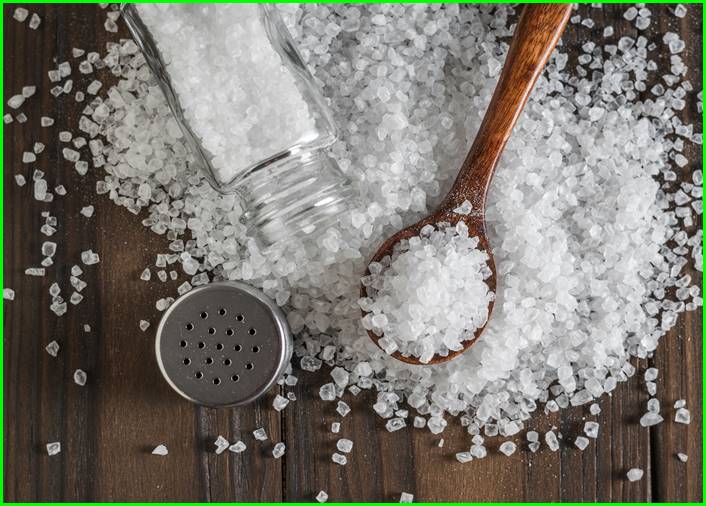Sea Salt – Types of Sea Salt & Health Benefits
The creation of sea salt involves evaporating salt water. People have been using it since prehistoric times, and it is still commonly utilized in many cuisines today.
The use of sea salt extends beyond its culinary uses to body scrubs, bath salts, and beverages.
Some people believe it is healthier than other types of salt and offers several benefits but there is little evidence to support these claims.
Read this article to discover the usual uses of sea salt as well as its potential health benefits.
What Is Sea Salt?
Sea salt is produced by evaporating water from the ocean or a salty lake. Because it retains some of the minerals and elements found in seawater, it can be used as a seasoning.
On the other hand, Table salt comes from underground deposits and goes through a lot of processing to get rid of impurities and minerals. Sea salt is not processed as much as other salt so it keeps some of its minerals.
It can be in the form of grains, crystals, or flakes and it can be white or gray. To know more about sea salt, Visit Ittefaq Salt – a sea salt supplier.
Sea Salt Vs. Table Salt – What’s The Difference?
Sea salt and table salt differ in several aspects. Their origin, taste, and manufacturing process. Most salt shakers contain table salt which is extracted from underground deposits and goes through a long process often with iodine added.
When sea salt is processed as little as possible keep its trace minerals, making it taste and look better. Table salt and sea salt have similar nutritional values. However, Sea salt and table salt contain comparable amounts of sodium by weight.
Types Of Sea Salt
There are different kinds of sea salt and each has its unique qualities that depend on where the saltwater comes from how it is made and what minerals are in it.
Here are some types of sea salt that you might find:
- Hawaiian Salt
The water around Hawaii in the Pacific Ocean is where Hawaiian sea salt comes from. Depending on the minerals and impurities in it. It can be white, pink, or red among other colors. The traditional Hawaiian salt is called Alaea salt. It is made by mixing red volcanic clay with salt which gives it a unique color and mineral-rich taste. It is a significant aspect of Hawaiian cuisine and culture.
- Fleur de Sel
This high-quality sea salt is hand-picked from the thin top layer of salt ponds or pools where salt evaporates. Flower of salt is what its name means in French. Fleur de sel has a texture that is wet and tiny crystals. Because it has a mild taste, and it is often used as a finishing salt to improve the flavor and look of a dish.
- Celtic Salt
Celtic salt comes from the Atlantic Ocean off the coast of France. It is also called Sel Gris or gray salt. It is light gray and feels a little bit wet because it keeps more water from the ocean. Mineral content can be different, and the taste is more complex than regular table salt.
- Smoked Salt
To make smoked sea salt you add smoke from different kinds of wood like oak, hickory, or apple wood to sea salt. This process gives the salt a distinct smoky taste which can boost food flavor. It is often sprinkled on grilled meats, vegetables, and even desserts at the end to give them a smoky aroma.
- Flake Salt
Sea salt that naturally forms small, thin, and oddly shaped flakes is called flake salt. The way these flakes are made allows for more surface area which gives them a unique texture that can be crunchy and dissolve quickly. People often use flake salt as a finishing salt to add texture and flavor.
Health Benefits Of Sea Salt
Sea salt is a natural source of essential minerals so it is more than a flavoring agent. It can help your health in several ways mentioned below:
- Keeps Electrolytes In Balance
Sea salt maintains electrolyte levels by replacing sodium, potassium, and magnesium which are important for muscle function, nerve signals, and staying hydrated.
- Regulates Blood Pressure
Getting the right amount of sodium from sea salt helps keep blood pressure steady which lowers the risk of hypertension and heart problems.
- Good For Your Skin
The minerals in sea salt clean and exfoliate your skin, opening up your pores, reducing inflammation, and giving you a healthy glow.
- Gives Food To The Adrenal Glands
By helping the adrenal glands work optimally, sea salt minerals help alleviate stress and keep hormone levels balanced.
- Reduces Fluid Retention
Getting enough sodium from sea salt can prevent your body from retaining too much water and making you feel bloated. As a result, your body’s fluid balance is maintained.
- Keeps Muscles From Cramping Up
Sea salt helps muscles contract and relax which makes it less likely that you will get painful cramps during workouts.
- Keeps You Hydrated
Sea salt balance electrolytes and make it easier for your body to absorb fluids which helps you stay hydrated.
- Helps With Digestion
Sea salt stimulates digestive enzymes which help break down food, make it easier to absorb nutrients, and make digestion go more smoothly.
Conclusion
Now you know everything about sea salt and its many uses. Even though sea salt can elevate the taste of food. Besides cooking, it can also be used for other purposes as well but there is not enough scientific evidence to support using it as a health remedy.
Vibrant Atmosphere: Immersing Yourself in the Mexican Spirit of Addison’s Kitchen and Tequila Bar
Sea Salt – Types of Sea Salt & Health Benefits
